| Author |
Message |
Chad Arnow
myArmoury Team


|
 Posted: Wed 10 Oct, 2012 8:59 am Post subject: Decorated scabbards Posted: Wed 10 Oct, 2012 8:59 am Post subject: Decorated scabbards |
 |
|
There have been a couple of comments in recent months about how modern scabbards are over-decorated with tooling and such. Those comments often come with further commentary about the disposable nature of scabbards. I find those comments interesting as we have brasses/effigies of certain periods that clearly show elaborate tooling. Even sheaths for everyday knives of all classes were tooled fairly extensively.
But there are plenty of surviving examples of period art with what appears to show smooth surfaces.
Edit for clarity: I'm most interested in the period 1000-1500AD, plus or minus a bit.
So, here's what I'd like to know:
1) Apart from the examples posted below, can people post examples of period sword scabbards that are decorated? Not just decorative metal work, but tooling to the surface of the body of the scabbard.
2) What hard evidence do we have that scabbards were more expensive (in some cases) than the sword? This is cited every now and then, including by scabbard makers justifying their prices.
If we can nail down some particulars perhaps we can begin to see if scabbards were tooled only in certain periods (like the early 14th century) or only in certain ways or in certain amounts. Modern reproductions sometimes get into sweeping scenarios like: If some scabbards were tooled, it's appropriate to tool them all. Or: If some scabbards were plain, it's appropriate for all of them to be plain. We can do better than that. Please note I am interested in historical data, not modern preferences.
I'd like to see if we can dispel some notions and get some good factual info. 
 Attachment: 43 KB Attachment: 43 KB
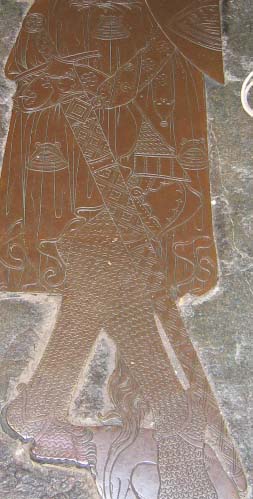
Robert (or William, depending on source) de Setvans, 1306
 Attachment: 97.08 KB Attachment: 97.08 KB

From rubbing of Robert (or William, depending on source) de Setvans, 1306. Better detail
 Attachment: 56.29 KB Attachment: 56.29 KB
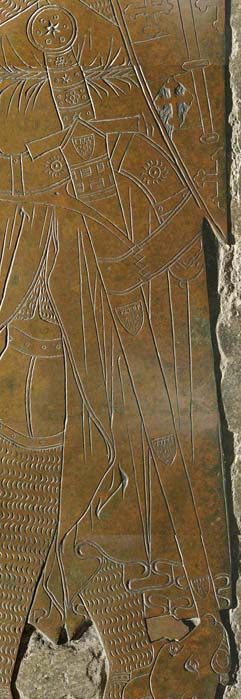
Sir Roger Trumpington, c. 1320. Heraldic shields down the scabbard.
 Attachment: 34.1 KB Attachment: 34.1 KB

Sir William FitzRalph, ca, 1323
 Attachment: 49.22 KB Attachment: 49.22 KB
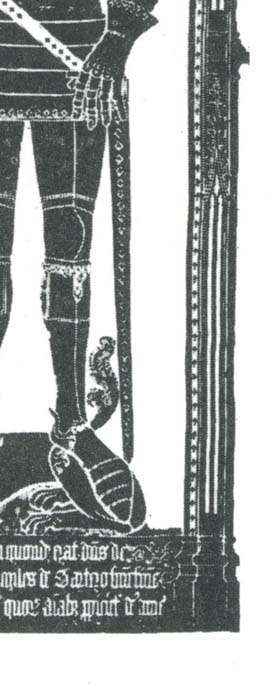
Baron Camoys, c. 1419. Diamond shaped decoration?
 Attachment: 37.3 KB Attachment: 37.3 KB

Edmund Clare, c. 1488. Simple pairs of lines

ChadA
http://chadarnow.com/
Last edited by Chad Arnow on Sat 13 Oct, 2012 9:27 pm; edited 1 time in total
|
|
    |
 |
Blaz Berlec

|
 Posted: Wed 10 Oct, 2012 11:08 am Post subject: Posted: Wed 10 Oct, 2012 11:08 am Post subject: |
 |
|
Some that I could find on Imareal and Bildindex.de. I know the last one isn't exactly tooled leather:

Kreuzigung Christi 1469 ; 1480 ; Wien ; Österreich ; Wien ; Schottenstift, Schottenaltar
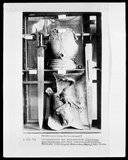
Schwert 1340/1400 & 1451/1500 & 1440/1490, München, Bayerisches Nationalmuseum
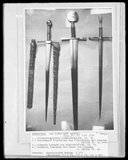
von links nach rechts: Schwertscheide und Kurschwert Friedrichs des Streitbaren mit Scheide und Schwert Konrads von Winterstetten und Schwert, Geschenk des Paolo von Gonzaga, 1501/1600 & 1401/1500, Dresden, Staatliche Kunstsammlungen Dresden, Historisches Museum, Inv.-Nr. I 273
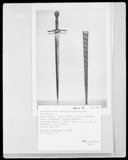
Kurschwert mit Scheide Friedrichs des Streitbaren, Ungarn, vor 1425, Dresden, Staatliche Kunstsammlungen Dresden, Historisches Museum, Inv.-Nr. VI/361 (Ehrenthal A34)
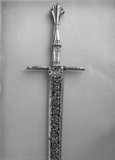
Zeremonienschwert mit Scheide, Köln, um 1450-1460, Köln, Domschatzkammer im Dom
Extant 15th Century German Gothic Armour
Extant 15th century Milanese armour
Arming doublet of the 15th century
|
|
   |
 |
|
Phillip Nussle
|
 Posted: Fri 12 Oct, 2012 2:19 am Post subject: Decorated scabbards Posted: Fri 12 Oct, 2012 2:19 am Post subject: Decorated scabbards |
 |
|
Hi Chad, this is interesting and something I've tried to solve for a while now. With the advent of over tooled work on some modern scabbards that look more like something from a Tandy catalog or a stock saddle. Many early brasses as you quite rightly point out show quite elaborate patterns on both the scabbards and hilts of these swords along with lockets and hangers to match. Some of these were no doubt embroidered as with the belts and not tooled leather. Another aspect is fine bead work introduced from the middle east and incorporated quite intricate designs in their makeup. Most leather tooling of later period scabbards seem to incorporate simple designs such as cross hatching or floral patterns such as vines, entwined as a religious symbol, or oak leave patterns. I think today we aim for some free license as to our own concepts of tooling and hampered probably more by the lack of designs available in the embossing tools themselves. A dozen tools made specifically to match that period would no doubt cost a small fortune. I look forward to reading your own findings in the near future.
If a man can see beyond himself and reason with all things then it's time for him to leave this earth and rise into the heavens.
|
|
  |
 |
|
Mart Shearer
|
 Posted: Fri 12 Oct, 2012 6:16 am Post subject: Posted: Fri 12 Oct, 2012 6:16 am Post subject: |
 |
|
Phillip's mention of beadwork brought to mind the belt of Fernando de la Cerda. I suspect anyone viewing an effigy or sculpture showing such an item might jump to the erroneous conclusion that it was tooled leather. When we see an escutcheon depicted on an effigial scabbard, how can we say whether it is cut leather or an enamelled gilt plaque?

I suspect Chad's 2nd question will be difficult to answer. I expect that some scabbards were more expensive than some swords. "Was any given scabbard more expensive than the sword it was designed to sheath?" is perhaps a more refined way of asking it. I'm sure we can find two widely varying figures for the cost of a sword in the same year or decade, but the expense of the furniture on a blade for a king wouldn't really be comparable to a munitions sword. Certainly the cost of decoration of any piece of armor or weapon could exceed the value of the base piece itself, considering the application of gold, gems, pearls, or holy relics.
ferrum ferro acuitur et homo exacuit faciem amici sui
|
|
  |
 |
|
Gregory J. Liebau
Location: Dinuba, CA Joined: 27 Nov 2004
Posts: 669
|
 Posted: Fri 12 Oct, 2012 8:11 am Post subject: Posted: Fri 12 Oct, 2012 8:11 am Post subject: |
 |
|
We certainly are seeing a lot of beautiful scabbards crop up here on myArmoury lately, almost exclusively crafted by members. Quite an array of work that's worth drooling over! As someone who's pretty serious about the development of scabbards between about 1000-1350, I'm always interested to see interpretations of scabbards that fall within this period.
My main criticisms of modern interpretations are thus:
Firstly, many of the tooled designs and devices incorporated on otherwise splendidly constructed scabbards are not reminiscent of what contemporary artwork shows us. I can honestly say that the only highly decorated scabbards I've seen on this site that do capture the feel were constructed by Leo Todeschini and Peter Johnsson.
I also believe that many of the period artworks' details that can be interpreted as tooling were in fact just painted designs over the top of a parchment wrapped scabbard. This is particularly true before the 14th century. Yet today, we see next to no scabbards that simply have nice paint jobs. Everyone seems obsessed with tooling. Of course, it's a more complex process that creates results that may seem more 'permanent,' but what little evidence I've seen regarding scabbards from the HMA suggests that paint is a viable alternative, and was likely more common in period.
Finally, too many risers. Before the later 14th century, if even then, I can't think of a single scabbard that uses more than perhaps a couple of risers near the top to hold the baldric assembly in place. Today's artisans often abuse the use of risers and pull from the historicity of a scabbard's other features in doing so.
Just my two cents.
-Gregory
Last edited by Gregory J. Liebau on Fri 12 Oct, 2012 8:20 am; edited 1 time in total
|
|
  |
 |
Chad Arnow
myArmoury Team


|
 Posted: Fri 12 Oct, 2012 8:19 am Post subject: Posted: Fri 12 Oct, 2012 8:19 am Post subject: |
 |
|
Gregory,
Criticism and opinion aren't in short supply in this debate.  I'm looking for facts/evidence that will help customers and makers know what's really correct. I'm looking for facts/evidence that will help customers and makers know what's really correct.

ChadA
http://chadarnow.com/
|
|
    |
 |
|
Gregory J. Liebau
Location: Dinuba, CA Joined: 27 Nov 2004
Posts: 669
|
 Posted: Fri 12 Oct, 2012 8:44 am Post subject: Posted: Fri 12 Oct, 2012 8:44 am Post subject: |
 |
|
Okay. The following scabbard is one of the main bits of evidence I've seen of painted decoration. I've only ever seen the sketch drawn of it in the early 20th century, but it has an apt description:

"Scabbard with Strap 1160-1220... The scabbard fragment in figure A was made from wood, covered with parchment, and decorated. At its mouth is a piece of leather cut into a half circle, and partially covered with green and red silk."
J. H. Hefner-Alteneck, Medieval Arms and Armor - A Pictorial Archive, p. 9.
Following are images of two original thirteenth century scabbards emphasizing the lack of risers and showing details regarding the baldric setups, which have also become unusually typical among modern examples. There are a variety of suspension systems to choose from!

Sword of Fernando de la Cerda, c. 1275.

Sword of King Sancho IV of Castile, c. 1298.
It's also important to note that most every Western European scabbard that survives from before the 14th century is almost completely devoid of tooling. Exceptions include obvious ceremonial pieces which usually incorporate metal fittings, garnets and wire decoration rather than tooled leather.
I've seen plenty of artwork and sculpture depicting decorated scabbards from this period, have the one confirmed example above showing a painted surface, a few literary references from Chanson d'Gestes or Minnesinger poetry, and nothing else...
|
|
  |
 |
Sean Flynt

|
|
   |
 |
Sean Flynt

|
 Posted: Fri 12 Oct, 2012 9:02 am Post subject: Posted: Fri 12 Oct, 2012 9:02 am Post subject: |
 |
|
ImaReal shows hundreds of decorated scabbards, usually through use of color and/or what appear to be applique, especially in the chappe. I'll see if I can find any in my files that suggest tooling.
As for price: I think this has been discussed elsewhere here, but I'm skeptical of the claim that medieval scabbards equaled swords. That might be true for the finest scabbards, with precious metal mounts, etc. For tooled, painted, etc., I just can't imagine why they would be expensive. Materials would have been very cheap. Labor would have been very cheap. Prices might have been controlled by guilds, but I can't imagine that in this period steel was so cheap, and wood so dear, that prices would have been anywhere near equity. Later periods, with mass-produced, rolled-steel blades and cast hilts, maybe.
I'm certainly open to evidence to the contrary.
This is not to suggest that I think the modern prices are out of line. Anybody who's made a scabbard and kept track of hours and material costs (holy cow, the leather!!!) knows that a master scabbard maker earns the money. But that reflects modern labor values, rarity of skill/knowledge, material prices, etc.
Anybody who can accurately reproduce the Bayerisches scabbards shown above deserves every penny of $1,000, and probably more.
-Sean
Author of the Little Hammer novel
https://www.amazon.com/Little-Hammer-Sean-Flynt/dp/B08XN7HZ82/ref=sr_1_1?dchild=1&keywords=little+hammer+book&qid=1627482034&sr=8-1
|
|
   |
 |
|
Gregory J. Liebau
Location: Dinuba, CA Joined: 27 Nov 2004
Posts: 669
|
 Posted: Fri 12 Oct, 2012 9:15 am Post subject: Posted: Fri 12 Oct, 2012 9:15 am Post subject: |
 |
|
| Sean Flynt wrote: | | As for price: I think this has been discussed elsewhere here, but I'm skeptical of the claim that medieval scabbards equaled swords. That might be true for the finest scabbards, with precious metal mounts, etc. For tooled, painted, etc., I just can't imagine why they would be expensive. Materials would have been very cheap. Labor would have been very cheap. Prices might have been controlled by guilds, but I can't imagine that in this period steel was so cheap, and wood so dear, that prices would have been anywhere near equity. |
Well, a good scabbard would require its wooden core, a lining typically of wool, an outer layer or two of parchment, all of the metal for fittings, the leather for a baldric and all paints and dyes associated with the project. In a non-industrial world, these elements would add up quickly. Quite possibly as fast as the bar of steel necessary to make a sword. This would be particularly true if fine materials were used, e.g. parchment made in Cordova or pigments from the East.
Very few materials in Medieval Europe were as cheap as labor. On the contrary, it's exactly why scribes so often recycled their parchment, why monasteries got involved in selling their excess 'home-grown' goods, and traders were willing to travel from England to Russia and back for particular items such as furs. The typical Medieval economy flourished due to the constant demand for raw materials, rather than any major advancements in organized labor or distribution of goods.
The point is that I wouldn't consider cost of materials a priority in this discussion unless if we're discussing those 'finest' of products. The finished sword/scabbard and its utility and quality were likely to be the primary factors in how much a man would pay. Just as today most people wouldn't consider how much money was spent building their Prius or Mustang, customers had priorities in the past. Compensating the manufacturer of a typical product's material value was probably rarely on their agenda.
-Gregory
|
|
  |
 |
Sean Flynt

|
 Posted: Fri 12 Oct, 2012 9:24 am Post subject: Posted: Fri 12 Oct, 2012 9:24 am Post subject: |
 |
|
| Gregory J. Liebau wrote: | | Sean Flynt wrote: | | As for price: I think this has been discussed elsewhere here, but I'm skeptical of the claim that medieval scabbards equaled swords. That might be true for the finest scabbards, with precious metal mounts, etc. For tooled, painted, etc., I just can't imagine why they would be expensive. Materials would have been very cheap. Labor would have been very cheap. Prices might have been controlled by guilds, but I can't imagine that in this period steel was so cheap, and wood so dear, that prices would have been anywhere near equity. |
Well, a good scabbard would require its wooden core, a lining typically of wool, an outer layer or two of parchment, all of the metal for fittings, the leather for a baldric and all paints and dyes associated with the project. In a non-industrial world, these elements would add up quickly. Quite possibly as fast as the bar of steel necessary to make a sword. This would be particularly true if fine materials were used, e.g. parchment made in Cordova or pigments from the East.
Very few materials in Medieval Europe were as cheap as labor. On the contrary, it's exactly why scribes so often recycled their parchment, why monasteries got involved in selling their excess 'home-grown' goods, and traders were willing to travel from England to Russia and back for particular items such as furs. The typical Medieval economy flourished due to the constant demand for raw materials, rather than any major advancements in organized labor or distribution of goods.
The point is that I wouldn't consider cost of materials a priority in this discussion. The finished product and its utility and quality were the primary factors in how much a man would pay for a scabbard or a sword. Just as today most people wouldn't consider how much money was spent building their Prius or Mustang, customers had priorities in the past. Compensating the manufacturer of a product was probably rarely on their agenda.
-Gregory |
Later basic scabbards were often much simpler than that. Leather over wood, and sometimes not even a chape.
-Sean
Author of the Little Hammer novel
https://www.amazon.com/Little-Hammer-Sean-Flynt/dp/B08XN7HZ82/ref=sr_1_1?dchild=1&keywords=little+hammer+book&qid=1627482034&sr=8-1
|
|
   |
 |
Chad Arnow
myArmoury Team


|
 Posted: Fri 12 Oct, 2012 9:27 am Post subject: Posted: Fri 12 Oct, 2012 9:27 am Post subject: |
 |
|
| Gregory J. Liebau wrote: | Well, a good scabbard would require its wooden core, a lining typically of wool, an outer layer or two of parchment, all of the metal for fittings, the leather for a baldric and all paints and dyes associated with the project. In a non-industrial world, these elements would add up quickly. Quite possibly as fast as the bar of steel necessary to make a sword. This would be particularly true if fine materials were used, e.g. parchment made in Cordova or pigments from the East.
|
As far as I know, there isn't much evidence for wool linings past the Viking era. And scabbards weren't always covered with parchment. Leather is a known covering.

ChadA
http://chadarnow.com/
|
|
    |
 |
|
Gregory J. Liebau
Location: Dinuba, CA Joined: 27 Nov 2004
Posts: 669
|
 Posted: Fri 12 Oct, 2012 9:29 am Post subject: Posted: Fri 12 Oct, 2012 9:29 am Post subject: |
 |
|
| Sean Flynt wrote: | | Later basic scabbards were often much simpler than that. Leather over wood, and sometimes not even a chape. |
Quite so. In such cases, I don't think one could argue that a scabbard cost more than a sword as far as material costs are concerned. I typically come at such questions from a twelfth or thirteenth century angle, when Latin Christendom was still expansive, generating new trade and manufacturing procedures constantly and material considerations were critical. I wouldn't argue from the same position for 15th-16th century Europe. I'm sure it was quite a bit easier to procure materials due to the inter-connectivity of the major commercial entities and the expansion of urban manufacturing, as well as the stranglehold on Eastern European resources that was the case by the 14th century.
| Chad Arnow wrote: | | As far as I know, there isn't much evidence for wool linings past the Viking era. And scabbards weren't always covered with parchment. Leather is a known covering. |
I'll have to look into the linings for the High Medieval period, as now that you mention it I'm entirely uncertain why I am under the impression linings were used after about 1000 or so. 'Tis a poser.
As far as parchment and leather are concerned, it's unlikely that one cost much more than the other before more industrious methods of tanning were developed in the later Medieval period. Half-tanned leather, which was apparently the leather of choice for cuir bouilli, requires a rather intense tanning process on par with making decent parchment. But, as I said, labor was cheap - material was not. You'd cut any slice of skin from a well-bred beast and it was usually worth some money, regardless of what product it would be finished into. Nice leather, nice parchment, whatever...
-Gregory
Last edited by Gregory J. Liebau on Fri 12 Oct, 2012 9:41 am; edited 1 time in total
|
|
  |
 |
Sean Flynt

|
 Posted: Fri 12 Oct, 2012 9:36 am Post subject: Posted: Fri 12 Oct, 2012 9:36 am Post subject: |
 |
|
This image is unique and instructive because in the case of the red sword at left, the artist clearly distinguishes between the gold of the locket and the gold of the chappe. The locket has depth. The decoration of the chappe does not, which suggests to me that it's painted ("shell gold," which was in use at this time). Gold stamping is a slightly later innovation, so would not be appropriate here.
Notice, also, that although the subtle texture and decoration of the grip are rendered, the body of the scabbard is without mark. This reinforces the sense I get looking at these images that in the case of fine swords, the body of the scabbard was more often considered to be the ground for display of fine metalwork, as in the other images below. Black and red set off gold beautifully, and if you have all that master goldsmith work, why would you undermine with even masterful leather tooling?
 Attachment: 177.38 KB Attachment: 177.38 KB
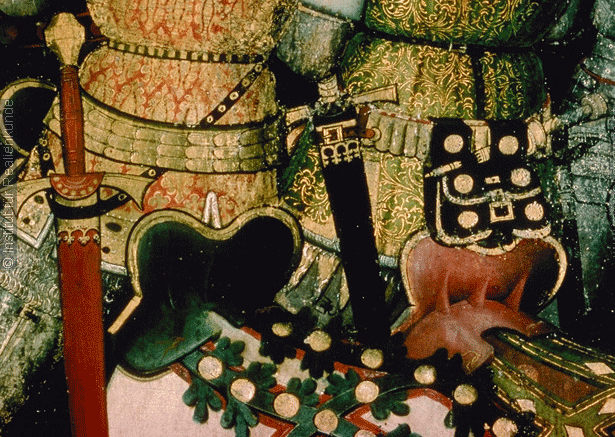
 Attachment: 197.86 KB Attachment: 197.86 KB
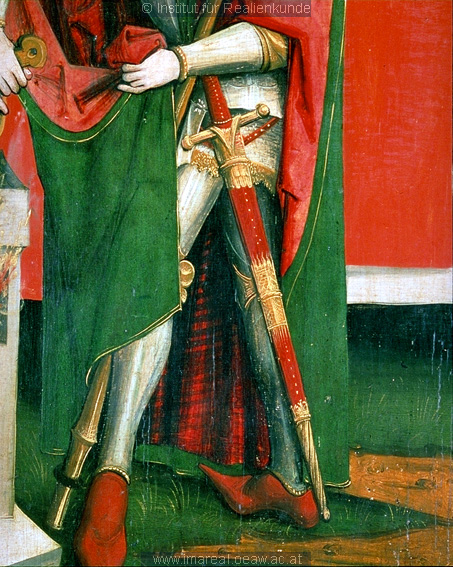
 Attachment: 131.25 KB Attachment: 131.25 KB
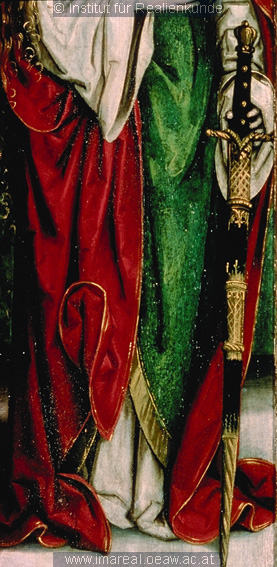
-Sean
Author of the Little Hammer novel
https://www.amazon.com/Little-Hammer-Sean-Flynt/dp/B08XN7HZ82/ref=sr_1_1?dchild=1&keywords=little+hammer+book&qid=1627482034&sr=8-1
|
|
   |
 |
Sean Flynt

|
 Posted: Fri 12 Oct, 2012 9:44 am Post subject: Posted: Fri 12 Oct, 2012 9:44 am Post subject: |
 |
|
Some examples of decoration on more common weapons, plus one not-at-all-common one. Note the apparent use of paint or fabric and tacks(?) on the chappe in the first image and the simple tooling of the chappe and scabbard in the second image.
If the last image is thought to have any basis in reality, it might depict a tooled and gold-painted scabbard, which would be an expensive decoration, for sure. Think about the most impressive gold-illuminated manuscripts. It would take a heap of shell gold to cover a scabbard.
 Attachment: 193.99 KB Attachment: 193.99 KB
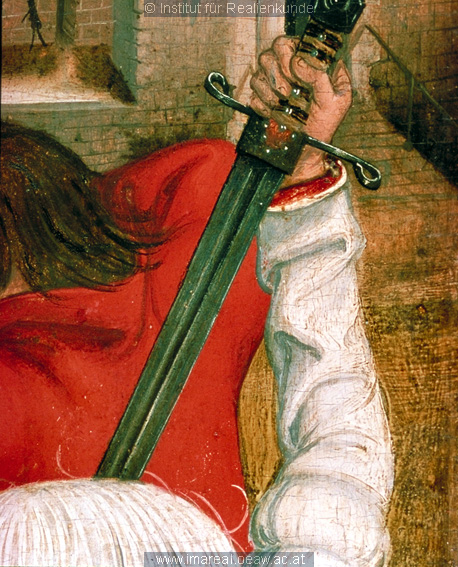
 Attachment: 198.55 KB Attachment: 198.55 KB
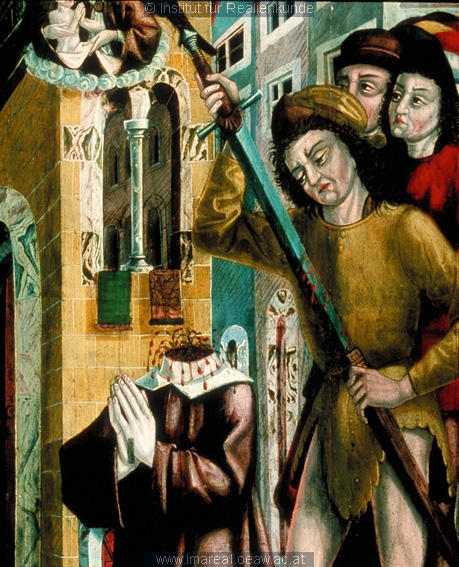
 Attachment: 189.41 KB Attachment: 189.41 KB

-Sean
Author of the Little Hammer novel
https://www.amazon.com/Little-Hammer-Sean-Flynt/dp/B08XN7HZ82/ref=sr_1_1?dchild=1&keywords=little+hammer+book&qid=1627482034&sr=8-1
|
|
   |
 |
Daniel Wallace

Location: Pennsylvania USA Joined: 07 Aug 2011
Posts: 580
|
 Posted: Fri 12 Oct, 2012 9:46 am Post subject: Posted: Fri 12 Oct, 2012 9:46 am Post subject: |
 |
|
|
we had a post about 6 months back where a gentleman asked for just about the same thing Chad, i know your looking for more tactile evidence - but i had posted about half a dozen pics from Albrecht Durer's wood cuts that show extensive tool work on sheaths. most of the images i have to work off of are very small, but it's apparent in every image of a sheath that there is some kind of decor to the leather. sometimes its just a central ridge - other times its geometric flower patterns. how much was his artistic influence on this - can't really say, but from his work you get the impression that if you had a sword of quality, you would have the leather work of equal quality to accompany it.
|
|
  |
 |
Chad Arnow
myArmoury Team


|
 Posted: Fri 12 Oct, 2012 9:49 am Post subject: Posted: Fri 12 Oct, 2012 9:49 am Post subject: |
 |
|
| Daniel Wallace wrote: | | we had a post about 6 months back where a gentleman asked for just about the same thing Chad, i know your looking for more tactile evidence - but i had posted about half a dozen pics from Albrecht Durer's wood cuts that show extensive tool work on sheaths. |
Indeed: http://www.myArmoury.com/talk/viewtopic.php?t=24846 . That thread covers a much narrower timeframe than this one, but has some great info. 

ChadA
http://chadarnow.com/
|
|
    |
 |
Sean Flynt

|
|
   |
 |
Thomas R.

|
 Posted: Fri 12 Oct, 2012 3:23 pm Post subject: Posted: Fri 12 Oct, 2012 3:23 pm Post subject: |
 |
|
Hi Chad,
I am very pleased to see, that our little conversation about tooled scabbards has sparked your researchers spirit! I'd like to contribute the little evidence I have for less tooled scabbards. This scabbard is currently at display at the Rothenburger Reichsstadtmuseum. I unfortunately don't know it's origin and age for sure, but I guess the plaque maybe associated with it, so it would be from the 14th century. It supports Seans claim of highly ornamented metalfittings for that timeframe. More than that you can see it's inner setup: thin wooden core, several, broad risers made with loops of string and a thin leather covering, which lacks any tooling. The scabbards mouth is covered in very ornate silver metalwork.
From the 15th century we know depictions of very plain scabbards, lacking any decorum like leather tooling, beads or coloring other than the dye used for the leather covering.
Regards,
Thomas
 Attachment: 194.16 KB Attachment: 194.16 KB
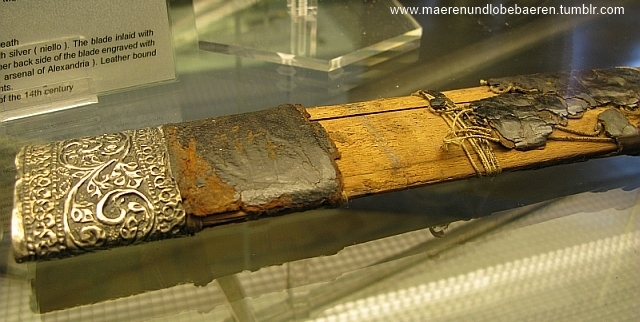
Scabbard, probably 14th century.
http://maerenundlobebaeren.tumblr.com/
|
|
   |
 |
Robin Smith

|
 Posted: Fri 12 Oct, 2012 5:28 pm Post subject: Posted: Fri 12 Oct, 2012 5:28 pm Post subject: |
 |
|
| Gregory J. Liebau wrote: | Finally, too many risers. Before the later 14th century, if even then, I can't think of a single scabbard that uses more than perhaps a couple of risers near the top to hold the baldric assembly in place. Today's artisans often abuse the use of risers and pull from the historicity of a scabbard's other features in doing so.
Just my two cents.
-Gregory |
Risers were in use, atleast pre-1000.
The Cronk Moar Scabbard
 Attachment: 49.55 KB Attachment: 49.55 KB
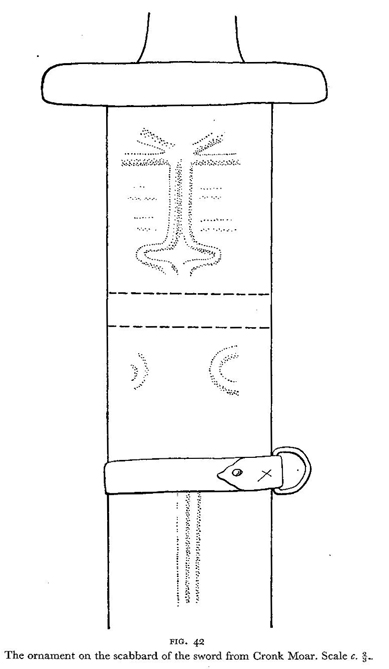
A furore Normannorum libera nos, Domine
|
|
   |
 |
|
|
You cannot post new topics in this forum
You cannot reply to topics in this forum
You cannot edit your posts in this forum
You cannot delete your posts in this forum
You cannot vote in polls in this forum
You cannot attach files in this forum
You can download files in this forum
|
All contents © Copyright 2003-2024 myArmoury.com — All rights reserved
Discussion forums powered by phpBB © The phpBB Group
Switch to the Basic Low-bandwidth Version of the forum
|

